These notes are taken from watching the video in the reference. Suppose we want to graph the function of the form,
First, if \(a < 0\), then we’ll run into complex numbers and other issues so typically the exponential function is defined for any base that is greater than zero. So Suppose \(a > 0\). We will still see that we have three cases:
- When \(a < 1\), we'll see something like this: (this is the function \(0.5^x\)). As \(x\) gets larger, \(y\) will approach \(0\). We can see this because \(f(1) = 1/2\), \(f(2) = 1/4, f(3) = 1/8\) and so on.

- When \(a = 1\), we'll see just the line \(y = 1\). \(1^x\) is 1 no matter what \(x\) is! so not really interesting.
- When \(a > 1\), for example when \(f(x) = 2^x\), then as the exponent gets bigger, we'll approach infinity. \(f(1) = 2, f(2) = 4, f(3) = 0\) and so on.

The trick to graphing these functions to always remember that we always have the points \((0,1)\) and \((1,a)\) plotted on our graph! so always evaluate the inputs \(0\) and \(1\).
The Domain and Range
It’s important to know the domain and range to help see what the functions would look like. The domain here is any real number so \((-\infty, \infty)\). What about the range? We can never reach any number that is zero or below so the range can be written as \((0, \infty)\). This also means that \(y=0\) is a horizontal asymptote.
Vertical Asymptotes
The domain is all the real numbers so we don’t have any domain issues and so we won’t have any vertical asymptotes.
Horizontal Asymptotes
so I know intuitively that for \(a^x\) for example, the graph never reaches 0 no matter what \(x\) values we plug in. This means that \(y=0\) is a horizontal asymptote. I’ve also seen tutorials define the asymptote of exponential functions of the form \(f(x)=ca^{x+b}+d\) to be \(d\). Either way? it’s kind of clear? or maybe now?
$$e^x$$
\(e^x\) comes up frequently but is there anything special about graphing it? not really. It is very similar to the above.

Vertical Shift
What happens if we’re about to graph a function like \(3^x - 2\). Notice here that we have a \(-2\). This is a vertical shift that will shift be the whole graph of the function down two units (green curve moved down 2 units from the original blue curve). Note that the horizontal asymptote is also going to shift to -2.

Horizontal Shift
A horizontal shift example is the following:
We know originally we had \(2^x\) along with a horizontal asymptote at \(y=0\) and the points \((0,1)\) and \((1,2)\). What’s going to happen now? The whole graph is going to shift 2 points to the left (opposite of the sign in the exponent). This means that the x coordinates of the all the points we plotted for the original graph will now decrease by two. So \((0,1)\) will be \(()-2,1)\). Similarly, \((1,2)\) will now be \((-1,2)\). One more thing that we usually plot is the y-intercept. To find it, we just evaluate \(f(0) = 2^{0+2} = 4\). The horizontal asymptote is unaffected here.

Reflection Around the Horizontal Asymptote
Suppose we’re graphing the following function:
We can see here that we have a negative sign in front of the exponential. \((- (3^x))\). This negative sign will reflect the whole curve around its horizontal asymptote which is \(y=1\) in this example. To graph this function, let’s start by graphing the original function \(3^x\) with the known two points \((0,1)\) and \((1,3)\) as well as the horizontal asymptote at \(y=0\).
Next,
- We have a vertical shift (+1) and so the horizontal asymptote will move up by one point be $$y=1$$. So the new points will be $$(0,2)$$ and $$(1,4)$$. The black curve ($$3^x$$) shifts up to become the purple curve ($$3^x+1$$).
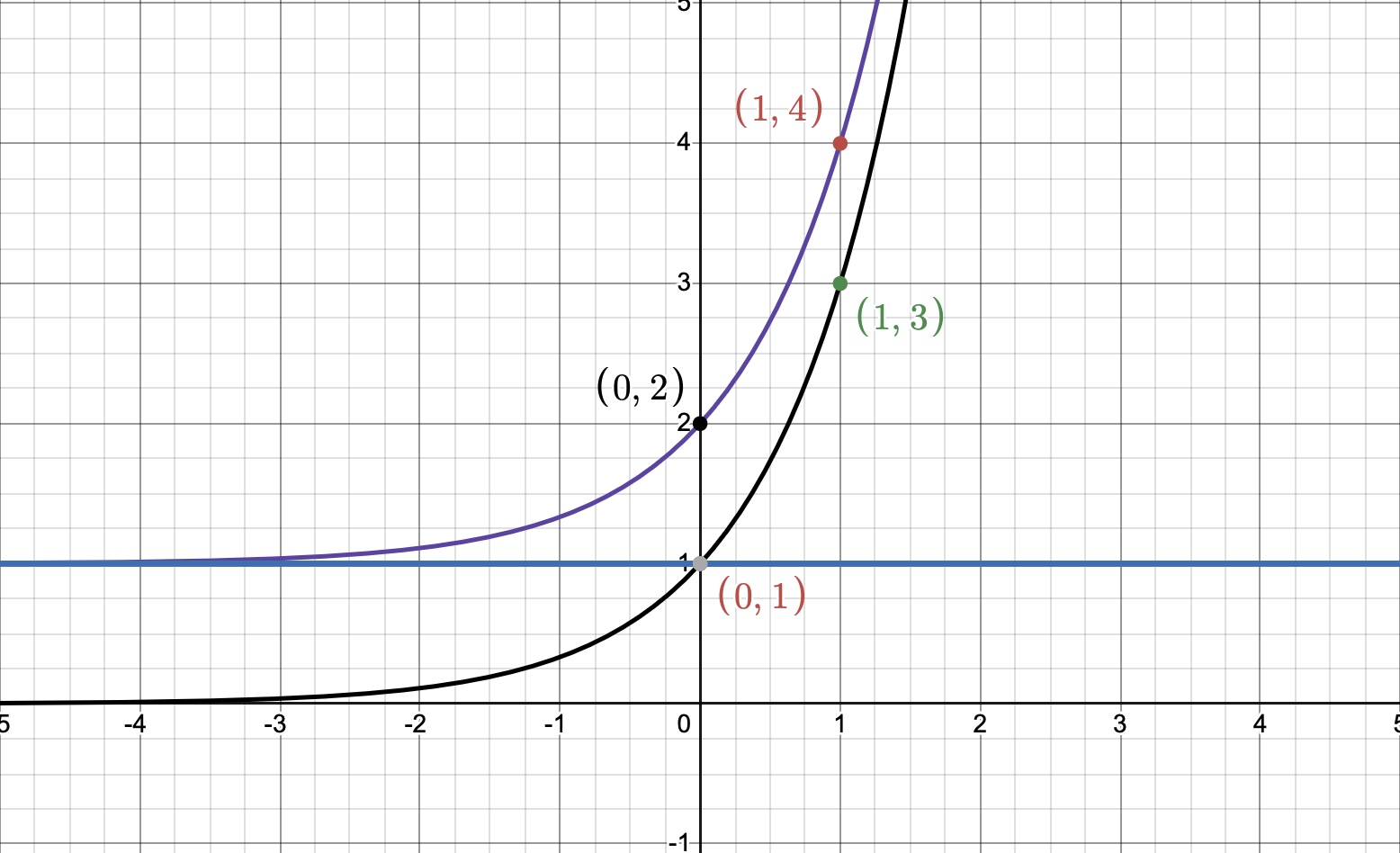
- The negative sign infront reflects the curve around the horizontal asymptote $$y=1$$. For this step it might also be easier to also evaluate the known points keeping in mind that we expect to see a reflection so $$f(0) = -(3^0)+1=0$$ and $$f(1) = -(3^1)+1=-2$$.
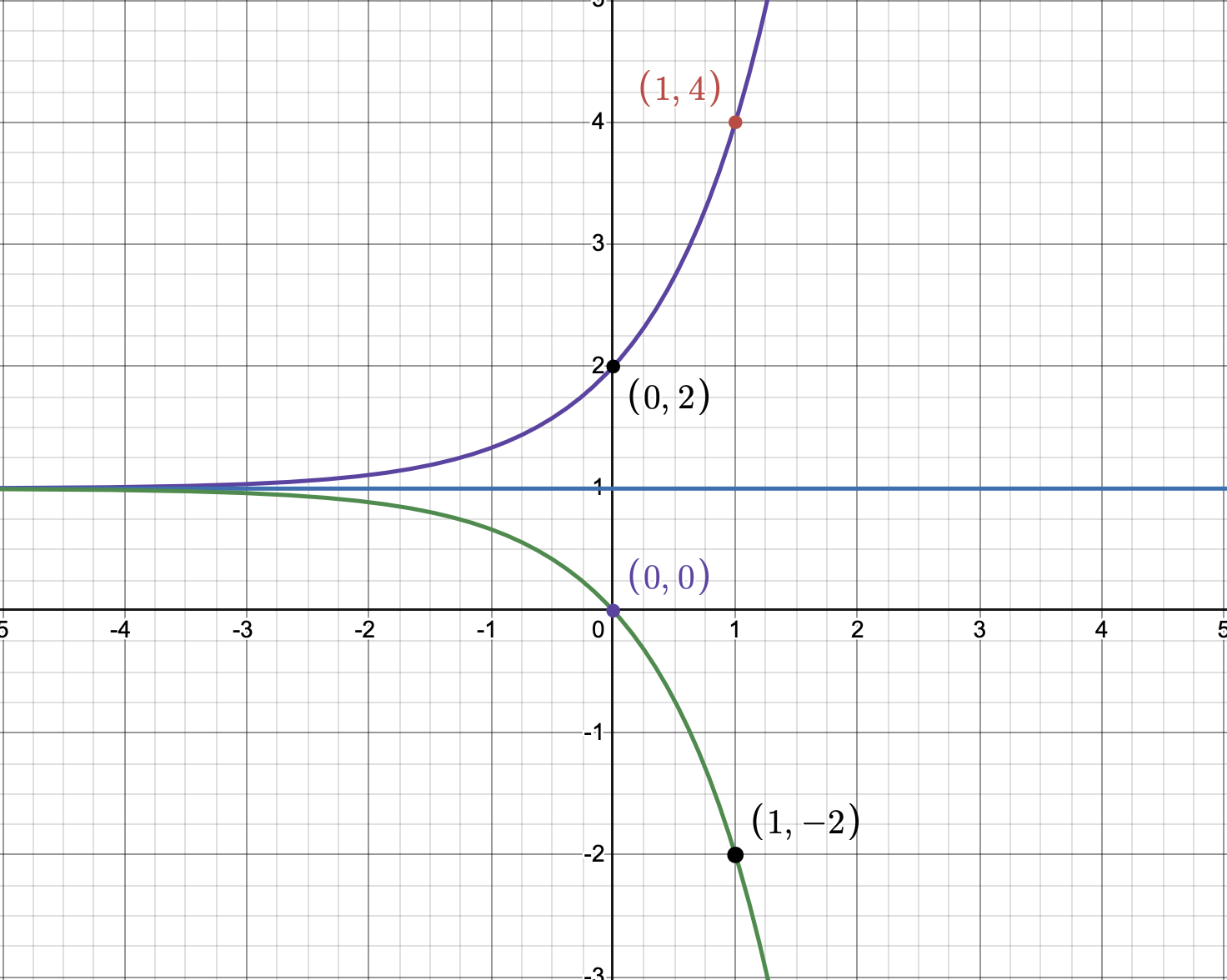
More Examples
Suppose we’re graphing the following function:
We have a lot going on here. Let’s re-arrange so that:
Before diving in, let’s graph the \(e^x\) so we can have something to compare against.
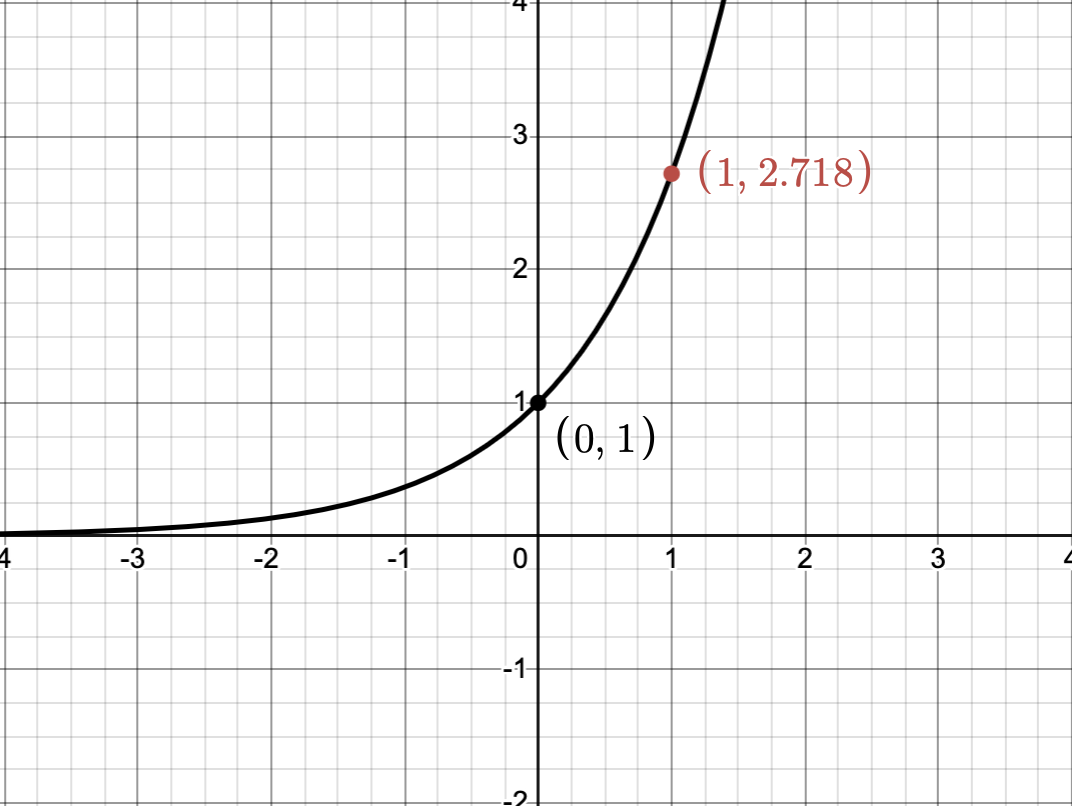
So this is (e^x) along with the points ((0,1)) and ((1,e)). Now, let’s dive into the transformations:
- If we look at the exponent and inside the parenthesis, we see that we have a -1. This means that it's a shift to the right by 1. This also means that our points' x-coordinates will shift by 1 and so \((0,1)\) and \((1,e)\) will now be \((1,1)\) and \((2,e)\).
- But what about the negative sign outside the parenthesis in the exponent? This negative sign will reflect the graph around the y-axis. But it's tricker here because we moved the points 1 point to the right! so what we want to reflect this graph around $$x=1$$ instead.
The red curve above is the graph of \(e^{-(x-1)}\).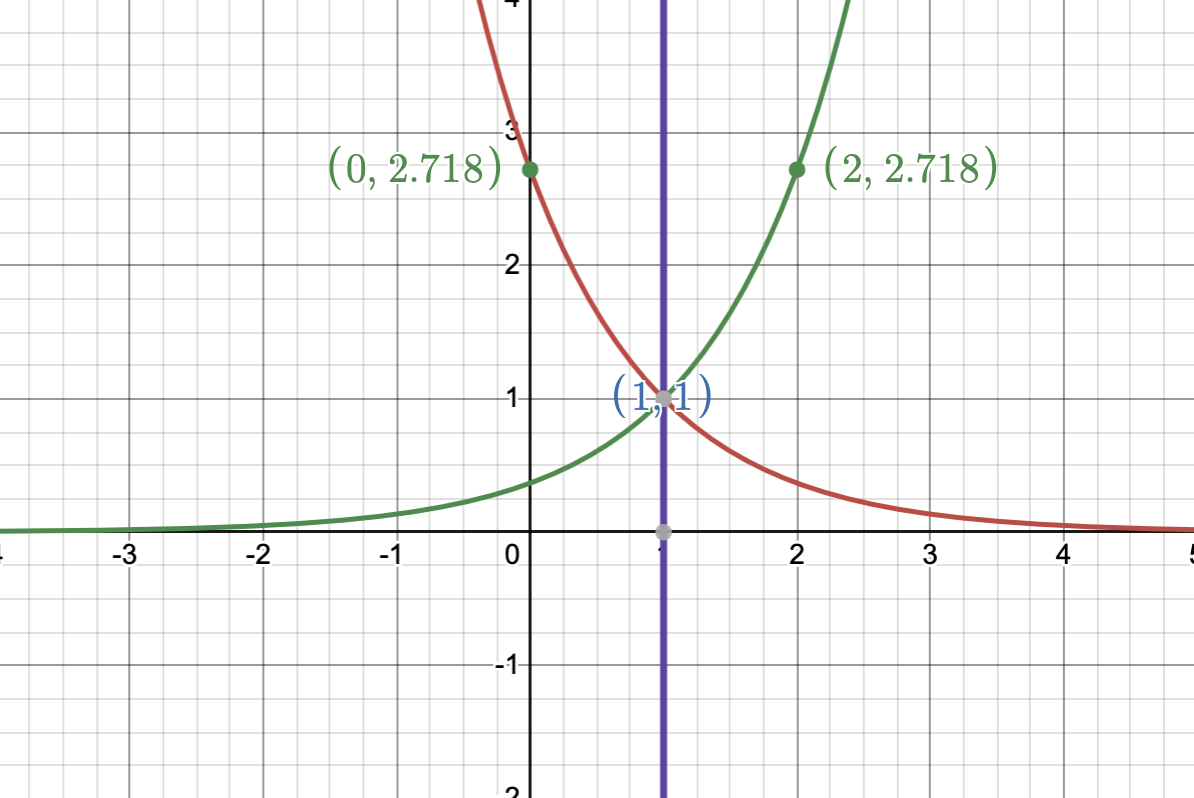
- Next we have the "2" factor at the beginning will just stretch the graph vertically by 2. There is also a negative sign. This negative sign will cause the curve to get reflected around the horizontal asymptote this time.
- Finally, the vertical shift is 5 so the horizontal asymptote moves to $$y=5$$ and the y-coordinate of all the points will be increased by 5.


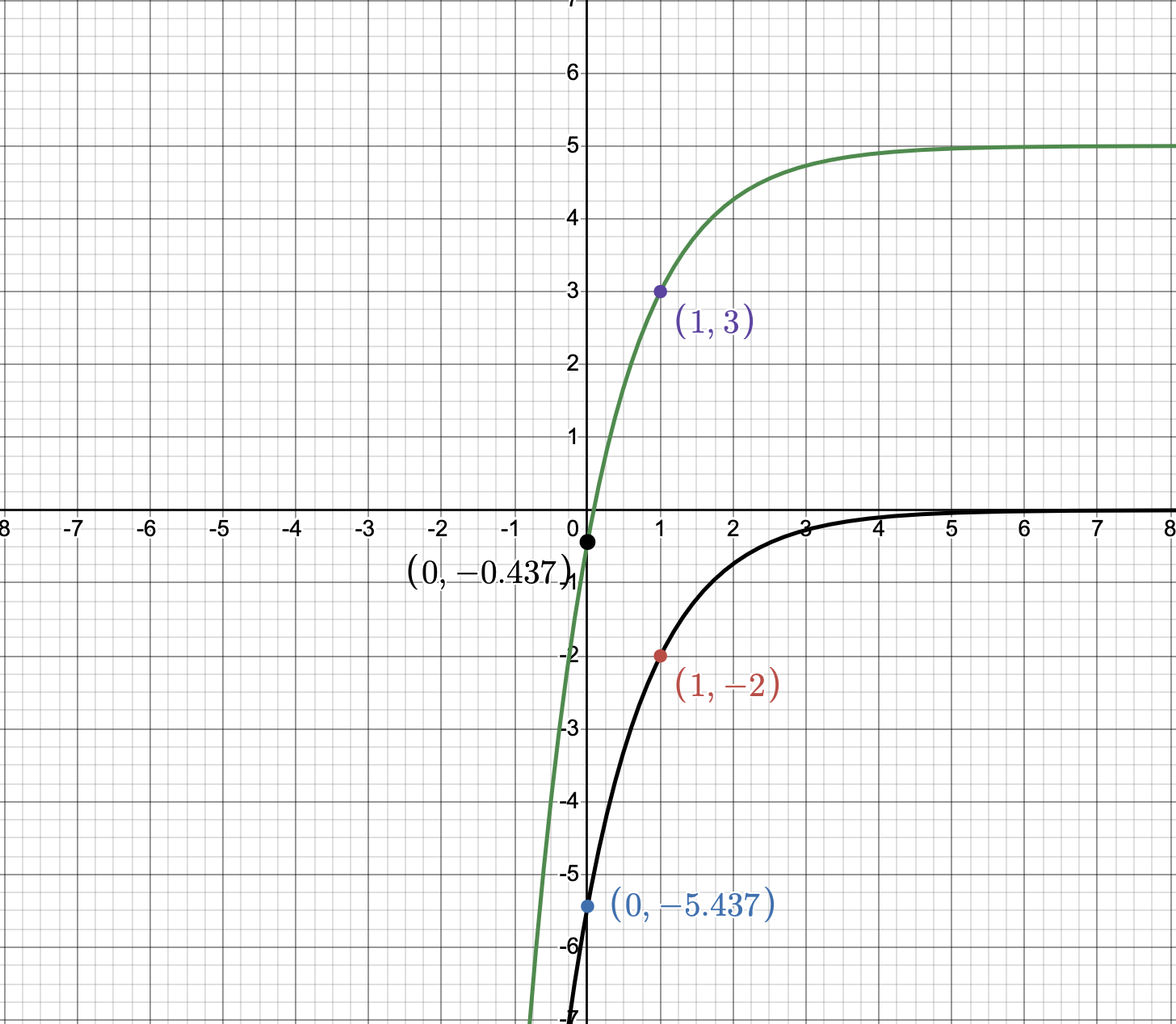
References: